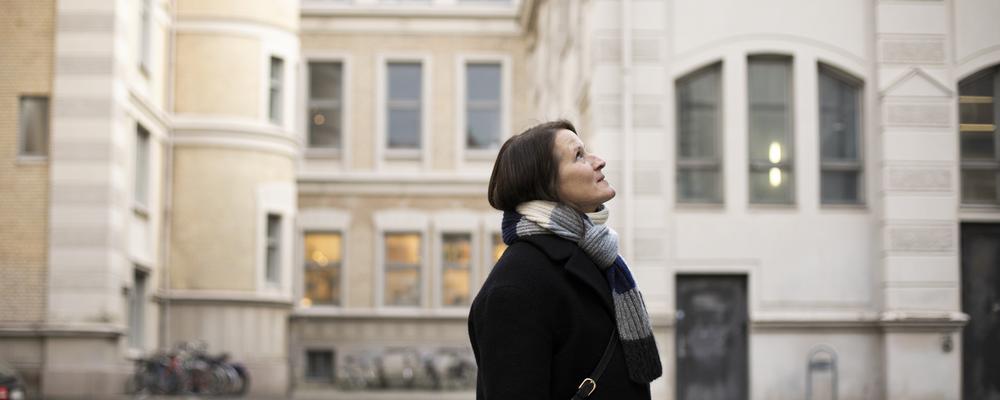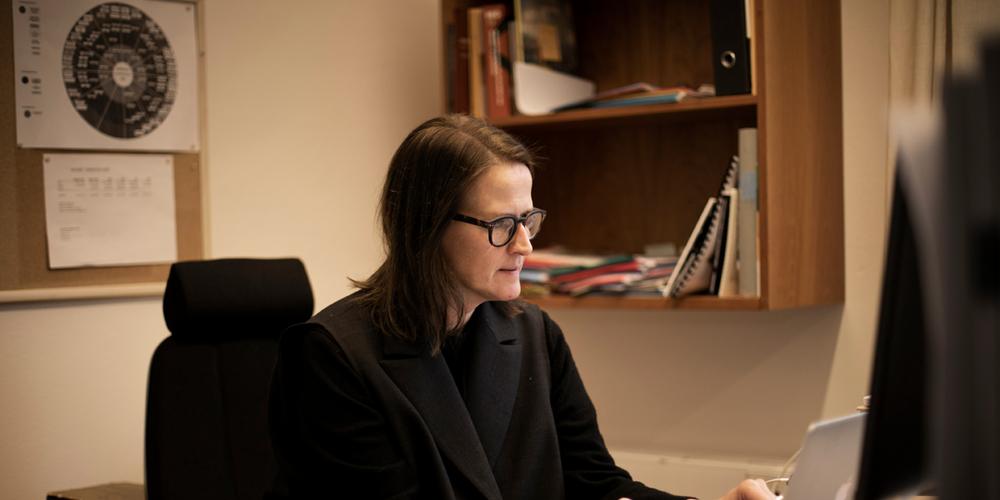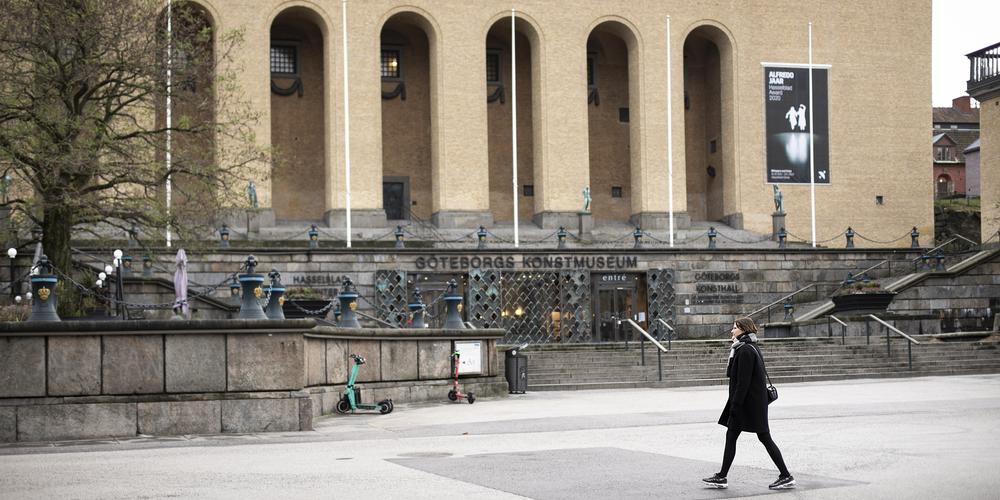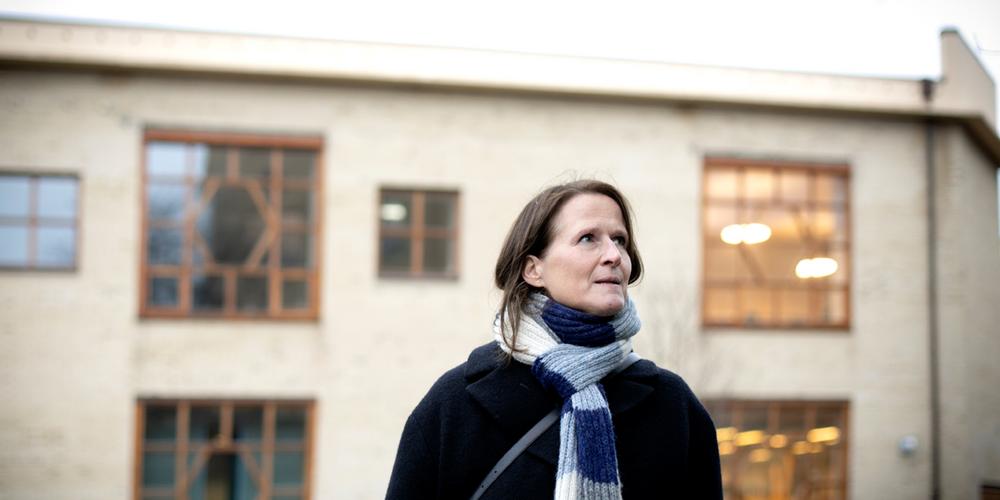
- Home
- News and events
- Find news
- Dean Shows the Way Toward a Joint Faculty
Dean Shows the Way Toward a Joint Faculty
It takes hardly more than ten minutes to walk from the Academy of Art and Design to the Academy of Music and Drama. And yet it’s a long road between them – one that extends both back in time and forward into the future. Follow along with Sanne Kofod Olsen, Dean of the Faculty of Fine, Applied and Performing Arts, on the road to a new building where all of the arts can come together.
From her office on Storgatan, Sanne Kofod Olsen can see the tram tracks leading up the city’s grandest street, Kungsportsavenyn. But starting in 2027, she and her 380 co-workers, 40 doctoral candidates and 1400 full-time students will be right around the corner from Götaplatsen. That’s when today’s Artisten, home to the Academy of Music and Drama, will expand into a new building for the entire Faculty of Fine, Applied and Performing Arts, except for the faculty’s Campus Steneby, 170 kilometers north of Gothenburg.
“It’s going to be a fantastic place to study,” says Sanne, “full of inspiring meetings between people – and between different art forms and academic disciplines.”

The idea for a new building first came up in 2012, when the faculty was undergoing a period of growth. The need arose for gathering together the faculty’s activities in one place, and now that idea is well on the way to becoming reality. A new building will be constructed as an expansion of the Artisten building. It will house design, film, photography, fine arts, industrial arts, literary composition, music, theatre, teacher training and niche art forms such as jewellery art and opera. The faculty's unique environment at Camups Steneby in Dals Långed will remain, with its crafts and design specializations in the materials wood, metal and textile.
“It’s going to be an environment that encourages fusions across art forms and academic disciplines,” says Sanne. “That can lead to new forms of art and give our students opportunities to develop niche area expertise that enhances their chances in the job market.”
Leaving her office on Storgatan, Sanne steps out into Teatergatan, her scarf carefully tied to protect against the Gothenburg wind. Just a few steps later, she passes the corner where it all began.
“In the building now occupied by the restaurant Valand, the first art school was established back in 1865. That was the seed that became the Valand Academy of Art and eventually today’s educational programmes in the Faculty of Fine, Applied and Performing Arts.”
Towering over us to the right is a magnificent red brick building that many Gothenburgers know as HDK – School of Design and Crafts. However, last year HDK merged with the Valand Academy, and all the activities inside the two buildings on Teatergatan are now part of the combined institution known as HDK-Valand – Academy of Art and Design. Carved in stone in the façade above the entrance staircase are the words Industrial Design Society School.
“When this building was constructed in 1904, it was designed for teaching classes in artistic subjects,” says Sanne. “Among other things, it included various kinds of workshops. That was unusual at the time, and today the building is a piece of cultural history.”

Sanne tears herself away from the view of the beautiful façade and with determined steps heads up toward Götaplatsen.
“It hurts a little to leave this building, but now we have a chance to create a new, exciting and unique place.”
But the vision for the future of the Faculty of Fine, Applied and Performing Arts is about more than just the new building. It also focus on sustainability, the school’s role as a seat of higher education and its place in Swedish society and the international community.
“We continue to attract students from all over the world to our programmes for gifted students. At the same time, we can’t all be stars, and the school needs to focus on every area in which a degree in the arts can be useful.”
The faculty will continue working to develop its initiative and enhance its profile as a research institution and its doctoral degree programmes.
“Unfortunately, art still has to justify itself in certain contexts, and science confers legitimacy. You need that in a society in which art plays an increasingly important role. Interacting with art, in all its forms, is a fundamental need for all people. That makes art relevant in and of itself. But it also creates an opportunity for reflection. If we want people to be thoughtful and empathic, we need art.”
Has always been fascinated by art
Sanne started out as an art historian focusing on fine art, performance art and feminist art. She has been fascinated by art for as long as she can remember.
“When I was little, I started wondering what different pictures mean and tried to understand what they have to tell me. That remains my greatest interest,” she says, smiling.

Here she reaches the destination of her walk. She makes a sweeping, rather proud gesture toward what is now a parking lot next to the Gothenburg City Theatre.
“Here there’s going to be a great big yellow building, and over here is where the entrance will be,” she says, mixing Danish and Swedish.
Sanne believes that visions and plans are important, but she emphasizes that development requires more than good intentions. Real change occurs in the here and now and between people.
“We are creating a place that encourages meetings and a structure that offers freedom of choice. And then it’ll be the students, with their ideas, talent, knowledge and experience, that form and develop this new place.”
By Åsa Rehnström